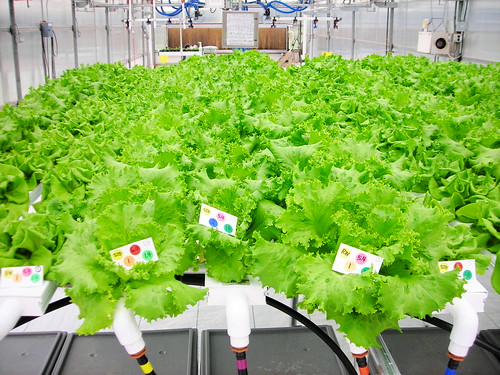Semi-hydroponics, Passive hydroponics or passive subirrigation is a method of growing plants without soil, peat moss, or bark. Instead an inert porous medium transports water and fertilizer to the roots by capillary action. Water and fertilizer are held in a reservoir and conducted to the roots as necessary, reducing labor and providing a constant supply of water to the roots.

Photo: orchidboard.com
Passive hydroponics does away with the need for water or air pumps, by depending on the capillary action of the plant's own roots to transport water and nutrients to it. It essentially involves growing the plant in a porous container with a reservoir containing water and hydroponic nutrients. This system allows the plant to take in only the specific amount of nutrition it needs. The most basic passive hydroponics system consists of a pot placed in a nutrient solution or a capillary mat saturated with nutrient solution.
In the simplest method, the pot sits in a shallow solution of fertilizer and water or on a capillary mat saturated with nutrient solution. Since routine maintenance is much simplified, passive hydroponics can reduce the labor required to maintain a large collection of plants.
Passive hydroponics, and other hydroponic techniques, offer many advantages over traditional methods of horticulture. Firstly, since a sterile medium is used instead of soil, the plant is protected against soil-borne diseases. Secondly, plants grown using hydroponics take up much less space than those grown in soil, which makes hydroponics the perfect choice for hobby horticulturists.

Photo: suretogrow
The various hydroponic media available contain more air space than more traditional potting mixes, delivering increased oxygen to the roots. Allowing air to reach the roots is particularly important in preventing root rot in epiphytic plants such as orchids and bromeliads, whose roots are exposed to the air in nature. Passive hydroponics also may add additional ambient humidity through evaporation. It is important in passive subirrigation to wash out the system from time to time to remove salt accumulation. Plants that require drying between waterings or a dry dormant period may fail to thrive under the constant moisture of passive hydroponics.
Sources: hydroasis.com, wikipedia.org

Photo: orchidboard.com
Passive hydroponics does away with the need for water or air pumps, by depending on the capillary action of the plant's own roots to transport water and nutrients to it. It essentially involves growing the plant in a porous container with a reservoir containing water and hydroponic nutrients. This system allows the plant to take in only the specific amount of nutrition it needs. The most basic passive hydroponics system consists of a pot placed in a nutrient solution or a capillary mat saturated with nutrient solution.
In the simplest method, the pot sits in a shallow solution of fertilizer and water or on a capillary mat saturated with nutrient solution. Since routine maintenance is much simplified, passive hydroponics can reduce the labor required to maintain a large collection of plants.
Passive hydroponics, and other hydroponic techniques, offer many advantages over traditional methods of horticulture. Firstly, since a sterile medium is used instead of soil, the plant is protected against soil-borne diseases. Secondly, plants grown using hydroponics take up much less space than those grown in soil, which makes hydroponics the perfect choice for hobby horticulturists.

Photo: suretogrow
The various hydroponic media available contain more air space than more traditional potting mixes, delivering increased oxygen to the roots. Allowing air to reach the roots is particularly important in preventing root rot in epiphytic plants such as orchids and bromeliads, whose roots are exposed to the air in nature. Passive hydroponics also may add additional ambient humidity through evaporation. It is important in passive subirrigation to wash out the system from time to time to remove salt accumulation. Plants that require drying between waterings or a dry dormant period may fail to thrive under the constant moisture of passive hydroponics.
Sources: hydroasis.com, wikipedia.org







